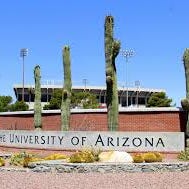
Arizona sports in limbo as university looks to ‘reset’ athletics budget
The University of Arizona leadership faces tough decisions in the months ahead.
Confronted with a $177 million budget shortfall, originally discovered last November, officials are scrambling to cut costs and boost revenue without harming the university’s investments in academics that faculty and students have fiercely defended.
One big-ticket item officials say they will target is the university’s athletic department, which interim Chief Financial Officer John Arnold said will need a complete overhaul to bring it into the ‘modern athletics market.’
So far, the university has announced ticket price increases for the 2024-2025 season as it looks to decide what the transformation will look like.
‘We need to reset their budget and install hard budget caps,’ Arnold said.
The Arizona Board of Regents, the body overseeing the state’s public universities, will bring on an external firm to help restructure the department. The firm, which the board is in negotiations with but has yet to name, will aid in streamlining athletic administration ‘from the ground up.’
The struggles the university faces aren’t unique. University president Robert Robbins has said he rarely sees college athletic departments turning a large profit. That’s part of a larger trend, University of Pennsylvania professor Karen Weaver said. Weaver studies the crossover between athletics and higher education.
‘The staffs have grown so large,’ Weaver said. ‘The salaries have grown so big.’
How did the athletics budget change over time?
Arnold said Arizona’s athletics revenue has remained largely stagnant for the last five to six years. Meanwhile, the school invested more in student-athletes amid changes to NCAA regulations.
He said funding went toward things like additional merit-based scholarships, equipment and food.
In fiscal year 2023, the university overspent its athletics budget by $32 million. In comparison, it overspent about $61 million on all of its academic units combined. Given the rising costs associated with collegiate sports, Arnold said there will need to be a shift in how people think about athletics funding.
‘It’s just unrealistic to think that athletics moving forward can be a stand-alone, self-funded unit,’ Arnold said. ‘In the modern athletics market, that’s just not possible.’
Arnold emphasized the school’s commitment to student-athletes, saying much of the changes will happen on the administrative side.
The transformation comes as the school prepares to transition into the Big 12 Conference, which could bring additional pressure. While the school is expected to make more through media rights, the shift could add more travel costs for the program when competing against far-away rivals like Cincinnati or West Virginia.
Would it be as easy as cutting certain sports?
In recent faculty senate meetings, some professors have questioned whether the university should keep each of its 23 varsity sports teams. Former athletics director Dave Heeke assured last month there were no immediate plans to cut teams.
Heeke left the program a little more than a week after updating the public on the state of athletics at Arizona.
University spokesperson Pam Scott said the school did not have an update on its athletics budget as of Thursday, but officials will need to act quickly to implement a new budget model by Jan. 1 of next year.
Weaver said balancing a budget isn’t as simple as cutting certain programs. She pointed to proposed slashes at Stanford that eventually had to be walked back after widespread backlash.
After a major loss of revenue during the COVID-19 pandemic, Stanford planned to cut 11 programs — many of which had produced Olympic athletes. After the school was hit with multiple lawsuits, officials reversed the decision and kept each of the teams.
Cutting sports teams, even smaller programs, always includes the risk of reputational damage or the loss of alumni donations, Weaver said.
‘So they really have to be very strategic about looking at the bottom line,’ Weaver said.
In addition, schools need to ensure they follow Title IX rules, which require them to provide equal opportunities for both male and female athletes.
What other changes could be made?
Cost-cutting doesn’t have to mean the loss of teams. Simple cuts could come from administrative streamlining in addition to caps on travel spending or professional development costs. The department has announced it will pause all major construction projects following the completion of building the William M. ‘Bill’ Clements Golf Center.
The university also looks to increase revenue brought in from athletics, which will begin with 2024-25 ticket price hikes for football and basketball. Arnold also has referenced possible rises in concession prices.
Weaver said collegiate programs may start to take inspiration from other schools to make more money. Some programs have added higher-priced tickets with special commodities. She cited Penn State University’s ‘Tunnel Club,’ where fans can pay a $10,000 membership fee to get access to a suite next to the stadium’s tunnel. A glass window allows fans to see the football team as it enters the stadium.
Weaver said inspiration could come from a variety of places if the school wants to explore new options.
‘So looking in Phoenix or Tucson, what kinds of changes are coming to professional facilities that they might be able to take advantage of on college facilities?’ Weaver said.
Looking at the big picture, Weaver understands concerns about how much money athletics departments at universities across the country spend. Still, she said sports remain a critical part of schools’ reputations.
‘If Arizona wants to be a top institution, a land grant that’s well-recognized and competitive with their peers in every aspect, this is part of it,’ Weaver said.
Helen Rummel covers higher education for The Arizona Republic. Reach her at hrummel@azcentral.com. Follow her on X, formerly Twitter: @helenrummel.
